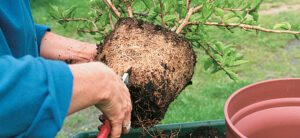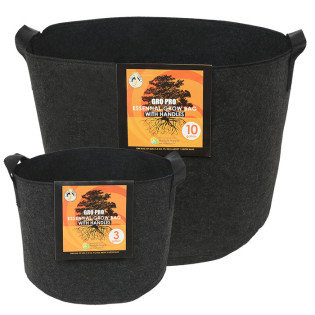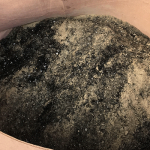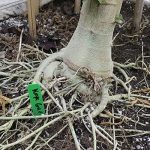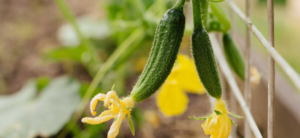
If are dealing with a root bound plant, you need to act quickly. It is important to get those roots untangled and your plant repotted.
All too often, plants that are purchased in containers at garden centers look fine when you buy them. But when you get them home you discover an issue. The roots are all bound in the pot and packed tightly into the container.
While you might think that a large root mass is ideal, this is only true if the roots can breathe!
The reality is that root-bound plants’ symptoms can be extreme and threaten the health of your plant. Sometimes plants that are left root bound for too long will even wilt and die.
Therefore, it’s important to understand how to re-pot a root-bound plant. You need to do this so that you can keep your plant healthy and growing well. And today, that’s what we’re going to cover.
First, we’ll teach you how to identify a plant with root circles (another term for root binding). Then, we’ll explain what can happen if you don’t do anything to remedy the situation. Finally, we will discuss how we recommend you go about repotting the plant.
What Does It Mean If A Plant Is Root Bound?
By their very nature, plants are meant to grow freely in the ground. Here, they have all the space they need to spread out their roots. However, most growers opt for container growing instead.
Container-grown plants are more susceptible to root binding. This is true whether you are growing plants in containers indoors or you are just growing houseplants.

When a plant’s roots are confined, it can suffer from a variety of symptoms that threaten its growth and life. Root bound plants are those that have grown too large for their containers. Occasionally, this issue occurs when a plant was put into a container that was too small to begin with.
Though becoming root bound is much more common in plants that are grown in containers, there are a few exceptions. Sometimes, plants grown directly in the ground become root bound if they are trapped between one or more solid barriers. This can happen from objects such as pipes, walls, or footers.
Will Root Bound Plants Die Eventually?
Knowing how to identify and treat a root bound plant is essential. Left unaddressed, bound roots can strangle and choke a plant. This will start depriving it of the nutrients and oxygen it needs to live. This can result in the loss of the plant.
The good news is that if you act quickly enough, you can easily remedy the situation with a transplant. First, we need to describe how to identify a plant that is root bound in the first place. This should be easy because you rarely have direct access to examine the roots!
What Are Root Bound Plants Symptoms?
There are several tell-tale signs that indicate a plant has become rootbound. The problem is that this issue is often confused with underwatering. Without digging up a plant and looking at its roots, it is very easy to treat the wrong ailment.
Root bound plants generally have symptoms such as wilting that comes on suddenly. They can also show brown or yellow leaves (often near the lower portions of the plant), and stunted growth. It could also cause a container to be pushed out of shape or even cracked by the roots.
If you see roots pushing above the soil, that’s another indication. This is showing that your plant has grown too large for its setting.
However, the only way to know for sure that your plant has bound roots is to look at the roots. To do this, you’ll have to remove the plant from its pot. Bear in mind that badly root bound plants will often be quite difficult to remove from their containers.
This is why these days, most growers utilize garden pots with holes at the bottom. By the time you see roots popping through these holes, you’ll know your plant has outgrown its home. This is a sign that it’s time to transplant!
How To Prevent Root Binding In The First Place
Instead of teaching you how to fix root binding, why not teach you how to prevent it? Preventing it from occurring in the first place is the best fix!
Sometimes, there is nothing you can do to prevent nature from taking over. But by properly selecting your garden pots and monitoring root progress, you can prevent your plants from creating root circles in the first place.
Stick With Fabric Pots Or Air Pots
Plastic pots have been the favorite for growers for some time. But these days, you're better off with a more breathable fabric like fabric pots or even airpots. These two containers allow for oxygen to enter the root zone, which air prunes the roots. Once your plant roots hit the wall of the pot, the air prunes them and prevents further growth.
This differs from plastic pots. Plastic pots allow no oxygen into the root zone and create conditions for roots to grow across themselves and tangle.
If you grow in one container from seed to harvest, choose a huge garden pot. Preferably one that is bigger than you suspect you may need. This will ensure your plants have more than enough room to produce their root mass.
Monitor Root Growth And Re-pot Before Its Too Late
Even when you grow in these fabric pots, you'll need to watch for root development. This can be tough in fabric pots that don't have holes in the bottom. This is because you won't be able to see the roots popping out.
But like we said, growing in air pots or fabric pots will prevent you from dealing with root binding. This will be the case more often than not.
However, if you're growing in a plastic pot, you'll need to transplant it into larger pots. You'll need to do this throughout your crop's life cycle. This is usually once after the first few weeks of veg and again before flower.
How To Re-pot A Root Bound Plant
The easiest way to mitigate the potentially life-threatening systems of a root bound plant is to re-pot it. It must be a larger container than the ones it's coming from.
If your plant is being grown in a container made of flexible material, it's easier to get the plant out. Just squeeze the pot in different directions to help loosen up the roots.

If the container is a hard material, like stone, ceramic, or terracotta, you’ll need to cut the plant out. Use a serrated knife with a long, thin blade to cut around the plant. Make sure you are staying as close to the edge of the pot as possible.
This should allow you to gently pry the plant from the pot. However, in very extreme situations, you may have to break the container that your plant was growing in.
After you’ve extracted the plant, take a close look at the root ball.
If the roots are wrapping around the rootball just a bit, then the situation isn’t too dire. You should be able to just place it in a larger container without taking too many additional steps. Of course, you should always untangle the roots before placing the plant in its new home.
If the roots have formed a solid mass with little soil to be seen, then you may want to prune. This is an important step before putting the plant into a larger container. Some plants can also be divided and repotted into two separate containers.
If you need to trim the roots in order to re-pot the plant into two separate containers, that is ok. Just remove no more than a third of the root mass, trimming from the bottom. Clip individual roots as needed - try to cut those that look the weakest or least healthy-looking first. Use sharp pruning shears and make sure they are sterilized first. You don’t want to risk spreading diseases to your plants.
To re-pot, put a bit of moistened soil into the new container. The soil should be at least a few inches in diameter and a depth larger than the existing pot. Tap down the soil lightly.
If you don't need to prune the roots, you can use your fingers to loosen up the root ball. Center the plant in the pot. The root ball should sit about one inch below the rim of the pot. Add soil to fill the remainder of the pot, firm, then water deeply.
Plants That Naturally Root Bind
If you’ve discovered that your plants have become root bound, your first instinct might be to panic. Your plant is going to die! You need to repot immediately!
However, in some cases, a plant becoming root bound should not sound the alarm. In fact, there are some plants that actually like being root-bound. They grow best under some level of stress and produce more beautiful blooms when their roots are packed tightly together.

This is the case with the Christmas cactus and the peace lily, two commonly grown houseplants. Repotting plants when their roots are bound will be a waste of your time. And, it can also cause the plant to bloom less vigorously. Rather than putting out new flowers, it will just continue to grow leaves.
There are other plants like aloe and spider plants that will not produce offshoots from a mother plant. Unless, of course, it is completely cramped. If you continue to transplant a root bound plant into a larger container, it will remain healthy. But, it won’t produce baby plants and allow you to grow the next generation of plants.
There are some other plants that do well when they’re feeling a bit cramped. These include the umbrella tree, ficus, asparagus fern, agapanthus, spider lily, snake plant, and jade plant.
Of course, there are some other plants that don’t necessarily like being rootbound but don’t transplant well, either. That’s the case with African violets and Boston ferns. Although these houseplants don’t do well in a small container, they will likely die if you try to transplant them. Because of that, it’s better to leave them be and hope for the best!
Final Thoughts On Preventing, Identifying, & Correcting Root Binding
Left unaddressed, a root bound plant will fail to grow well and can even die. This is because the roots of the plant spiral around it and ultimately choke it out.
Don’t let this happen! Inspect plants for root binding when you buy them and repot your plant if you realize it is becoming root-bound.
To prevent this problem in the future, grow plants in the right size container. You can find everything you need for healthy container growing. Do your shopping with the large selection of supplies and growing containers at Hydrobuilder. From small to large, indoor to outdoor, we have everything you need for a successful season.





